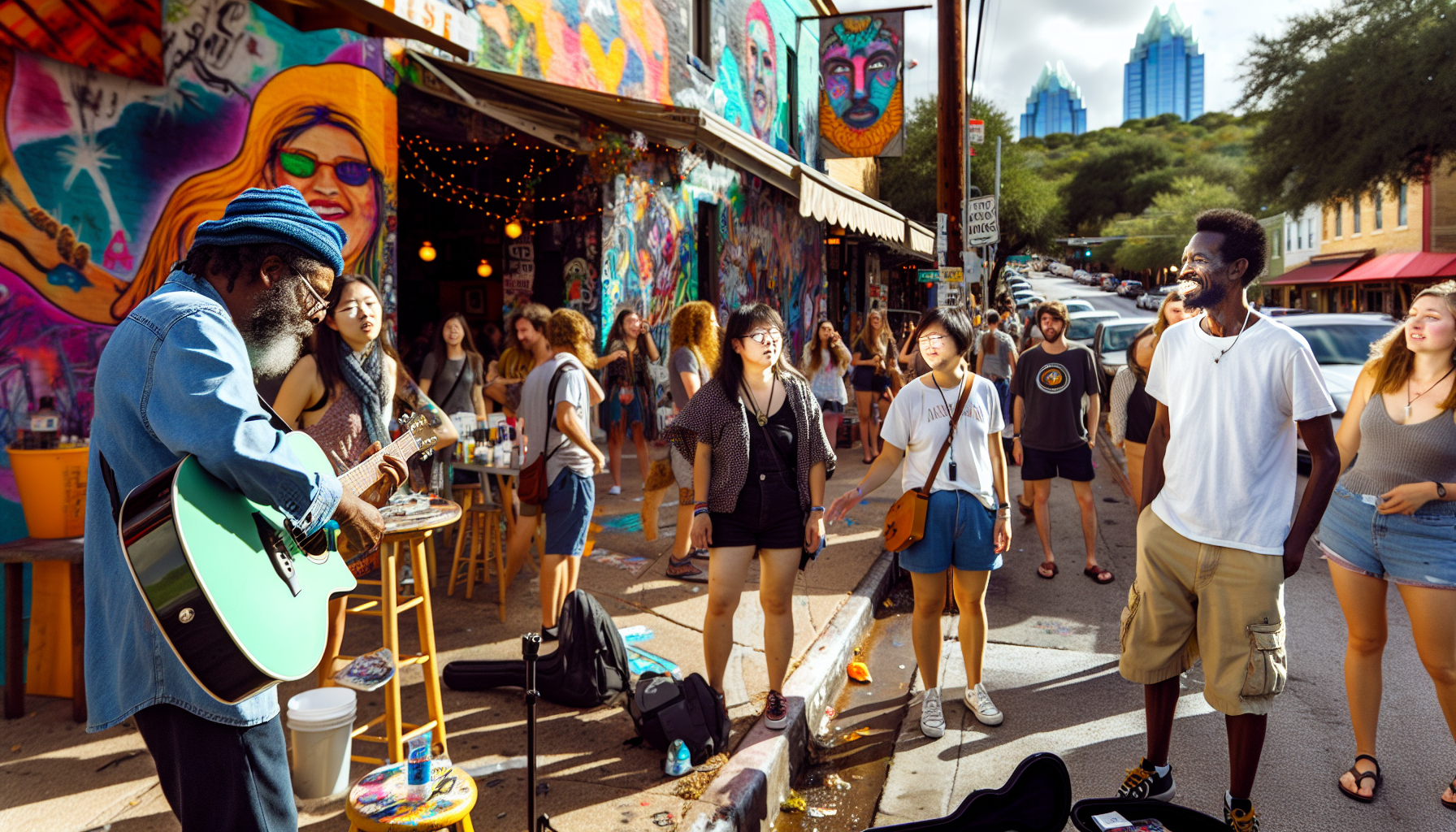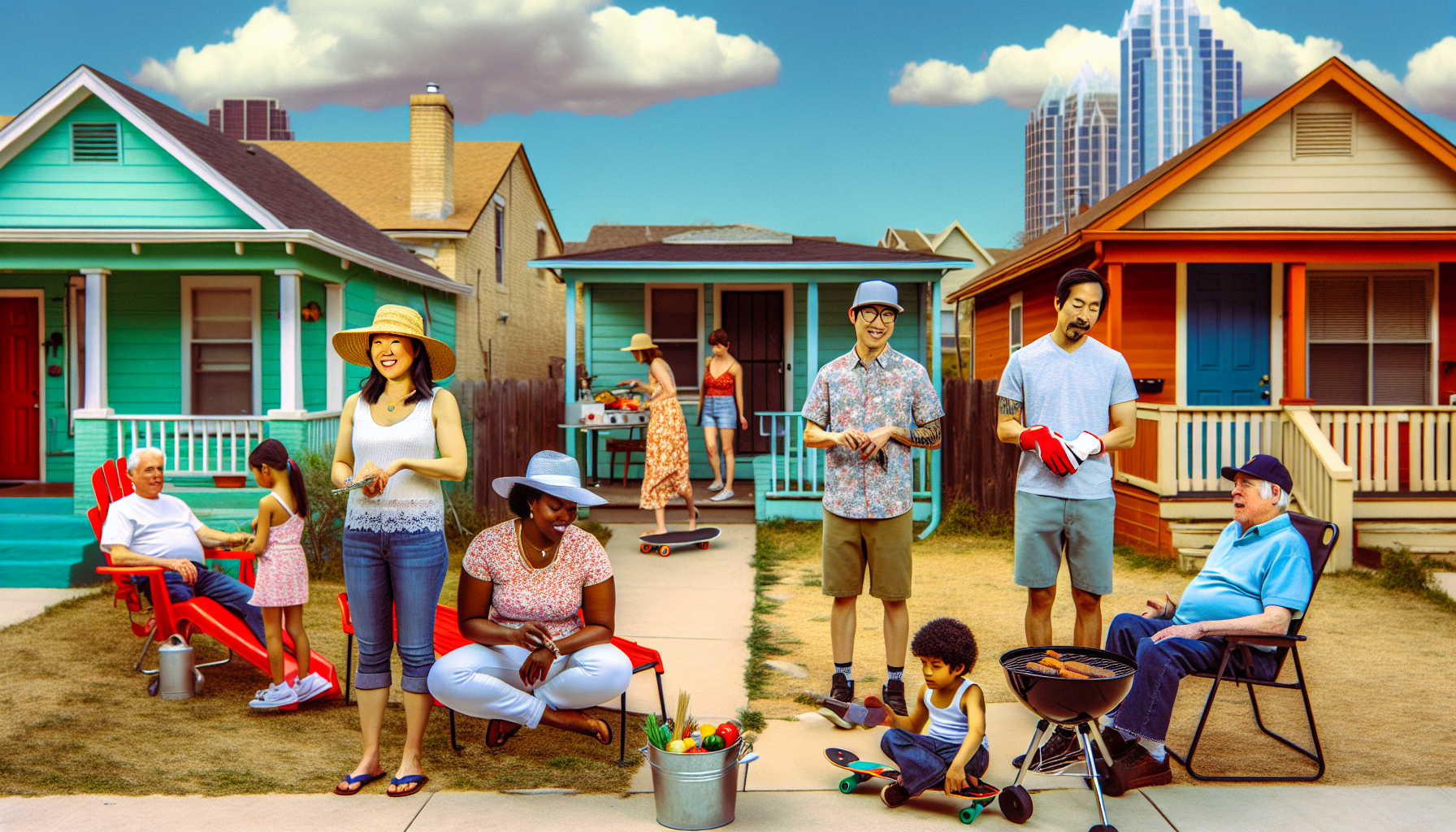Your Essential Checklist for Moving from Seattle to Austin: Tips for a Smooth Transition

Feb 18, 2024
Considering moving from Seattle to Austin? Prepare for more than just a change in scenery. Economic housing, no state income tax, and a booming job market are just the beginning. This article distills essential insights into how life in Austin stacks up against your Seattle experience, ensuring your move to the Lone Star State is well-informed and worry-free.
Key Takeaways
- Austin offers a sunnier climate with comfortable months in April, October, and November, and the cost of living is significantly lower than in Seattle, with no state income tax and more affordable housing options.
- Austin’s job market is diverse and booming, particularly in the tech sector, contributing to the city’s reputation as ‘Silicon Hills’, though opportunities abound in various other industries as well.
- Austin offers a vibrant lifestyle with outdoor activities, a unique cultural scene with music festivals like Austin City Limits, diverse culinary experiences, and varied neighborhood options from family-friendly to urban living.
Embracing the Heart of Texas: Your Journey from Seattle to Austin

Trading the cool, fresh atmosphere of Seattle for Austin introduces you to a warmer and more sun-drenched environment. With its 228 sunny days on average and intense summer heat, Austin presents a significant change from the temperate climate of Seattle. Those relocating need not fret excessively about the temperature. Pleasant relief is found during April, October, and November—ideal times for acquainting oneself with this new metropolis.
When contemplating such relocation considerations, expenses are paramount. The high living costs in Seattle are well-known, but assessing how they measure up against those in Austin is crucial.
Decoding the Cost of Living: From Seattle's Skyline to Austin's Horizon
If you’re considering relocating from Seattle to Austin, your budget may find some relief. The cost for housing is almost half in Austin compared to Seattle. For instance, a studio apartment averages around $1,330 in rent in Austin while the same type of living space would cost approximately $2,010 in Seattle. Regardless if you are searching for a one-bedroom flat or something as large as a four-bedroom house, more economical alternatives await you in Austin.Austin does not offer an advantage with respect to housing costs. The general expenses associated with living there are about 3% lower than the national average. In contrast, Seattle, where living costs soar at 49% above the national standard. Consequently, moving from Seattle to Austin should resultantly yield substantial financial savings – and this holds true across various types of accommodations available within Austin’s real estate market.
Navigating Housing Options: Renting vs. Buying in Austin
The housing landscape in Austin caters to a broad spectrum of preferences, with options available for both renters and buyers. The city is home to many renters. Nearly 50% of the population opts for rental living arrangements. In this vibrant market, you can find anything from shared rentals and quaint bungalows to expansive family homes.If you’re considering buying property in Austin, it could prove financially beneficial. Downtown Austin showcases a median home value of $831,905 while the charming Bluebell Ridge area – known for its family-friendly ambiance – lists average home values around $743,000. Whether your tastes lean towards bustling city life or serene suburban settings, there’s an array of dwellings suited to every lifestyle choice within Austin.
Moving on to fiscal matters concerning state income taxes.
Understanding Tax Implications: More Bang for Your Buck in Texas
It’s worth noting that in Texas, you won’t have to deal with state income tax, allowing your earnings to stretch further. This offers potential for substantial financial savings compared to states such as Washington where residents are subject to a state income tax. Austin does present higher property taxes when compared to Seattle. But even with this in mind, the lack of state income tax and the Lower cost of living may render Austin more economically feasible than Seattle overall.Now that we’ve addressed expenses and housing factors, it’s time to focus on the dynamics of Austin’s job market.
The Pulse of the Job Market: Finding Your Place in Austin's Economy

In Austin, the employment scene is characterized by its vibrancy and constant evolution. The city has experienced a remarkable streak of job growth, continuously expanding for 27 months straight as of 2023. Over the span from December 2022 to December 2023, Texas boasted an employment increase rate at a brisk pace of 2.7%, surpassing the national average by a full percentage point. This expansion spans across various sectors. It’s not concentrated in just one area. In fact, within Texas, seven out of eleven primary industries reached new heights in terms of employment numbers, indicating that Austin’s job market is highly diversified.
Within this bustling economy are key segments driving Austin’s economic progress.
- The Financial Activities sector which enjoyed a surge in jobs amounting to an increase of 3.4%,
- Education and Health Services which experienced even stronger growth with job numbers rising by 4.4%,
- Technology also stands out as an influential force amidst Austin’s industry landscape.
Tech Industry Triumphs: Silicon Hills Meets the Emerald City
The tech industry in Austin has established itself as a significant player. Consider these important figures:- A growth of 9.8% in job opportunities during the year 2022
- An impressive increase of 34.5% over the past five years
- Home to approximately 9,800 high-tech companies
- Accounting for 195,879 jobs within the technology sector
- Totaling payrolls amounting to $29.7 billion in the recent year of 2022
- Representing an imposing share at 30.2% of all metropolitan payroll
Notwithstanding its thriving technological environment that led to “Silicon Hills” becoming a moniker synonymous with Austin, there is more diversity within its employment market beyond just technology industries.
Diverse Employment Avenues: Beyond Technology
In Austin, while the tech industry is indeed a major player in driving the economy forward, there’s also significant expansion happening across various other sectors within its job market. Noticeable employment upticks have been seen in several non-tech industries such as:- Trade, Transportation, and Utilities with 7,100 new jobs
- Private Education and Health Services which added 6,800 roles
- Leisure and Hospitality that increased by 6,800 positions
Lifestyle and Leisure: Merging Seattle's Charm with Austin Weird

Life in Austin is enriched by a diverse selection of outdoor pursuits available to its residents. From the excitement of swimming, exploring trails on foot, to the joy of cycling, those with an affinity for open-air leisure will find ample options that cater to their hobbies. Austin encourages eco-conscious travel through its Active Transportation Program—a feature likely attractive to those from Seattle who favor green commuting alternatives.
What distinguishes Austin’s essence and gives it distinct character is its singular cultural vibe—compassed by the famous slogan “Keep Austin Weird”.
Keeping Austin Weird: A City of Festivals and Free Spirits
The city of Austin dances to its own unique rhythm. Its music scene, epitomized by Austin City Limits, has been instrumental in cementing the town’s status as the Live Music Capital of the World and is integral to both its cultural identity and heritage. The evolution from a quaint college town into a bustling urban center can largely be attributed to festivals such as South by Southwest and Levitation Music Festival.While Seattle boasts an important arts and music scene, it’s through events like these that Austin radiates a distinctively lively artistic vibe. And when it comes to culinary offerings?
Culinary Adventures: From Coffee Culture to BBQ Bliss
Get ready for a gastronomic treat if you’re passionate about food. Renowned for its fresh seafood, diverse Asian flavors, and distinguished coffee scene, Seattle serves up a feast that’s as delightful as it is varied. On the other hand, Austin boasts signature BBQ flavors, authentic Tex-Mex delights, and an energetic array of food trucks.Indulge in Seattle by enjoying a warm cup of their famed coffee or traverse to Austin where biting into succulent BBQ sandwiches awaits. These two cities are veritable playgrounds for culinary exploration with unique offerings that stand out distinctly. But when navigating through Austin’s dining landscape, one might wonder about transportation options and the state of traffic within the city.
Getting Around: Transportation in Austin Versus Seattle

Navigating a new urban environment can often be tricky. When moving to Austin, you’ll find that owning a car or opting for accommodation near your workplace or academic institution is advisable. This could differ significantly from what you might expect if Seattle’s extensive public transportation system has been your reference point up until the move.
There’s no need to fret about potential traffic snarls just yet. We’re here to provide some local knowledge on how best to handle daily travel in Texas’ capital city and make living in the Lone Star State as smooth as possible.
Traffic Tales: Commuting in the Lone Star State
Austin, similar to other large urban centers, contends with significant traffic jams, particularly in the mornings and evenings when commuters are on the move. One can lessen their impact by traveling outside these busy times. Doing so before 7 AM or after 8 PM on weekdays is typically advisable. Austin residents also commonly take advantage of less-trafficked alternative roadways to skirt around heavily congested motorways during peak travel periods.For adeptly maneuvering through Austin’s traffic flows, leveraging real-time information from transportation apps and updates from local news outlets can be invaluable. For those concerned about finding a spot for their vehicle downtown, valuable assistance is available through resources provided by the Parking Division of the City of Austin. And regarding public transportation options within the city?
Public Transportation Prospects: Metro Services and Accessibility
The public transportation network in Austin, run by Capital Metro, is made up of various services including:- The MetroExpress
- The regular MetroBus service
- The commuter train known as MetroRail
- And the high-frequency bus line, MetroRapid Route 801
Armed with these details, your mind might now be turning towards orchestrating your relocation. We’ll dive into the planning process shortly.
Planning Your Move: Strategies for Long-Distance Relocation
The process of moving between states may seem daunting, but with careful planning, a smooth and worry-free transition is possible. By beginning your preparations eight to twelve weeks prior to your move date, you can allocate sufficient time for all the necessary steps. Employing a moving checklist will help you keep tabs on every task that needs attention before, during, and after relocating.Paring down your possessions by getting rid of items you no longer need can play a significant role in reducing the bulk of what has to be moved—this downsizing effort directly impacts lowering overall moving costs. And while packing up your household goods, it’s crucial to set aside essentials in a specific box or suitcase for immediate access upon arrival at your new residence. Next comes one very important decision: choosing which company will handle the heavy lifting and transportation involved with your move.
Selecting the Right Moving Company: Allied Van Lines and Others
Choosing the right moving company is crucial for a smooth transition. Begin by confirming the legitimacy of companies by checking their USDOT number, and gauge their trustworthiness through customer testimonials. For those relocating from Seattle to Austin, Coleman-Allied comes highly recommended as a dependable option among various Austin movers within the realm of Austin moving companies.Once you have selected an appropriate moving company, it’s important to plan your financials with careful consideration given to the differing services offered by various moving companies.
Budgeting Your Move: What to Expect
The expense associated with relocating over a long distance can vary widely, determined by elements such as the move’s size and the total miles traveled. Typically, costs for a long-distance relocation fall between $3,000 to $5,000 or higher. Specifically for those moving from Seattle to Austin, you could expect full-service movers to charge anywhere from $1,310 up to $11,220. While container services utilized during moves might cost you in the range of $1,211 through to around $6,061.Your final bill for moving may be significantly affected by factors like:
- The inclusion of extra services
- Accessibility of parking space for the mover’s vehicle
- Current market trends
- Overall availability of moving companies
With your transition completed into Austin, where starting an enterprise is planned next, let’s delve into this process.
Settling In: Making Austin Your New Home

The city of Austin, TX is celebrated for its dynamic neighborhoods known for their welcoming atmosphere, excellent education options, fairly priced housing market, and lively night scene. The city also dedicates efforts to maintain its cultural essence by preserving key historical areas like the Red River Cultural District and Black East Austin along with the Mexican-American Fifth Street Corridor and historic 4th street LGBTQ+ venues despite developmental challenges within Austin.
Like Seattle, Austin offers some of the best educational institutions around, showcasing the high caliber of schooling opportunities available in Austin for those relocating there. One might wonder about establishing a new circle of friends after moving to a different urban center.
Building Your Network: Social Circles and Community Engagement
Getting involved with local community organizations and being a part of area happenings can make integrating into the Austin lifestyle smoother, while also helping you to forge new social connections. The city boasts numerous vibrant community groups including neighborhood associations, recreational sports leagues, and clubs centered around various hobbies that are open to embracing newcomers.Signature yearly festivities such as Austin City Limits and South by Southwest offer excellent chances for networking and immersing oneself in the cultural fabric of Austin. Offering your time to volunteer is another fulfilling avenue to connect with people within the city. There’s an abundance of charities and nonprofit events consistently in search of volunteers.
Now it’s time to help you discover your perfect neighborhood in this lively city.
Finding Your Ideal Neighborhood: Family-Friendly to Downtown Living
Austin offers a variety of neighborhoods to suit the unique lifestyles and tastes of its residents. The Bluebell Ridge area is celebrated for its family-friendly atmosphere, boasting excellent schools, cycling trails, parks with playgrounds, meandering creeks, and community gatherings that include festivals and concerts showcasing music.Conversely, Downtown Austin caters to those who thrive in an energetic urban setting. It’s home to 12,848 people seeking the vibrancy of city life. Regardless if you’re drawn to tranquil suburban living or the excitement of downtown buzzes—Austin has a neighborhood perfect for your preferences.
Summary
From embracing the sunnier climate and the cost of living to understanding the job market and the unique culture, moving from Seattle to Austin is an exciting journey. With careful planning, the right moving company, and a clear budget, you can ensure a smooth relocation. Once in Austin, immerse yourself in the community, build your social network, and find the perfect neighborhood to call home. As you embark on this new chapter, remember that the charm of Seattle and the weirdness of Austin can coexist to create a unique, enriching experience.Frequently Asked Questions
Is it more expensive to live in Seattle or Austin?
Based on the cost of living index, residing in Seattle is 8% pricier than in Austin, Texas. To sustain an equivalent lifestyle, one would require approximately $7,598.5 in Seattle as opposed to $6,700 in Austin.Is it worth moving to Austin Texas?
Certainly, relocating to Austin, Texas is a move worth considering. This city boasts a robust economic climate, inviting warm temperatures, and an energetic cultural milieu that adds to its allure as a place of residence.The city caters to a diverse range of individuals including eager young professionals and those seeking leisurely retirement life.
What is the cheapest way to move from Washington to Texas?
Renting a moving truck and handling the move yourself is likely the cheapest way to move from Washington to Texas.Good luck with your move!
How is the job market in Austin?
Austin’s job market is lively and undergoing robust expansion across multiple sectors, with the technology industry showing particularly strong growth.As such, it presents an excellent location for those seeking to pursue career prospects.
How can I avoid traffic congestion in Austin?
To circumvent traffic jams in Austin, consider navigating the city during times that are less busy and opt for different pathways.Scheduling your trips to avoid peak travel times can significantly reduce encounters with heavy traffic.
- Categories
- Austin Texas |
- Real Estate How-Tos



